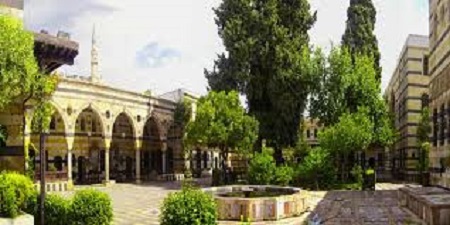Qasr al-Athm Palace in Old Quarter of Damascus- Masterpiece Archeological Heritage Returns to Spotlight in “Culture in Your Home”Event
Qasr al-Athm Archaeological Palace in the old quarter of Damascus is yet to restore its role in cultural life,notably impacted by the Corona virus measures. The Palace shall host a concert by Orpheus Orchestra next Monday, within the activities of “Culture in Your Home”.
Occupying an area of more than 5500 square meters, Qasr al-Athm Palace is a unique example of Islamic architecture and that made it center of many activities and events.
In his booklet Palace of the Athm Family in Damascus, researcher Issa Iskandar al-Maalouf noted that this residence building is located between the Umayyad Mosque in the north and Medhat Pasha market (Straight Street) in the south. It is one of the most important historical residences in the old quarter of Damascus, and one of the most extravagant and typical examples of traditional domestic architecture in Damascus. It was built on the site of the ruins of Muawiyah’s Palace and some shops in the area. The building stones were brought from several places such as present-day Marje Square and Kiwan land.
 The construction of Qasr al-Athm required a span of two years and over 800 builders and craftsmen for completion. It consists of three wing sections: Salam-lek for men, Haram-lek for women, and Khadam-lek for servants.
The construction of Qasr al-Athm required a span of two years and over 800 builders and craftsmen for completion. It consists of three wing sections: Salam-lek for men, Haram-lek for women, and Khadam-lek for servants.
Arranged around a courtyard are reception halls, rooms and a large Ewan(open space overlooking the courtyard) with a long pond of water similar to that of al-Areef Paradise in the Alhambra Palace in Granada, Andalusia, Spain. External walls of rooms and halls are decorated with colored stones covered with ornaments, as elaborately painted wooden panels decorated the interior walls and ceilings of the reception halls and rooms.
Since 1954,the Directorate-General of Antiquities and Museums has worked to transform the palace into a museum of folk traditions, collecting exhibition items either as gifts or through direct buying from various Syrian regions, thus turning the palace into a tourist attraction center, visited daily by more than four thousand people.
In the rooms and halls of the palace, we find a wide variety of Damascene and traditional artifacts and collections that tell, in their entirety, a popular story about daily life in the Damascene house.
We can also see, within the reception halls, an exhibition of handmade glass- making by blowing technique, straw-made dishes and wood carpentry with models of damask wood furniture, inlaid in mother-of-pearl, ivory and copper.
In the other wings of the palace, there is one for making copper dishes and another for women & men textiles. It also includes a hall for a scene that represents daily life activities of Damascene women, in which you find a statue – figure of a woman sitting in front of a coffee pot placed on a copper grill, sipping her coffee in front of two other women figures playing barjis game.
 A big room in the palace was used as a popular café, with a shadow puppet theatre, a musical takht (ensemble), a world box play toy, and two people playing the Mancalaboard game.(a traditional Syrian board game)
A big room in the palace was used as a popular café, with a shadow puppet theatre, a musical takht (ensemble), a world box play toy, and two people playing the Mancalaboard game.(a traditional Syrian board game)
The rooms at Qasr al-Athm contain representative models of weapons used in the past, some of which date back to the Middle Ages, as well as models of shields, helmets, spears, Damascene swords and their sheaths.
Rayan Faouri

